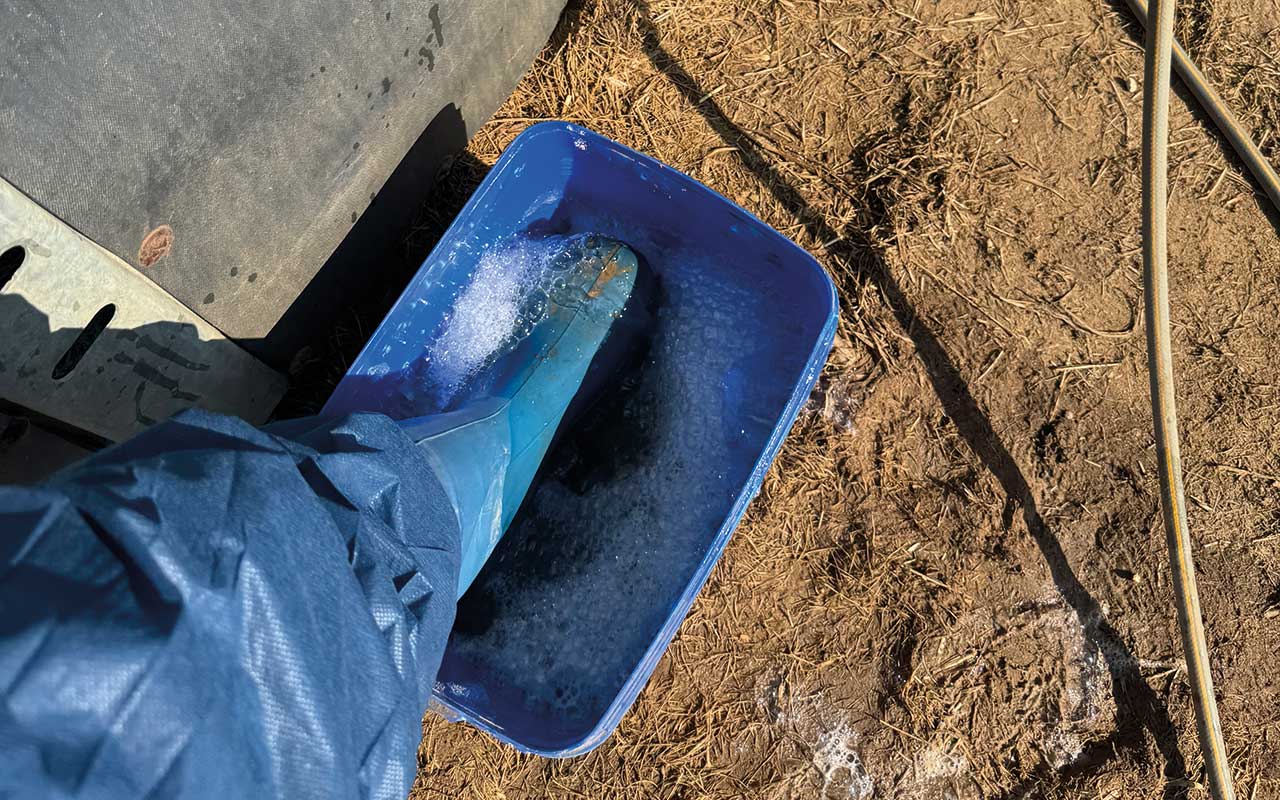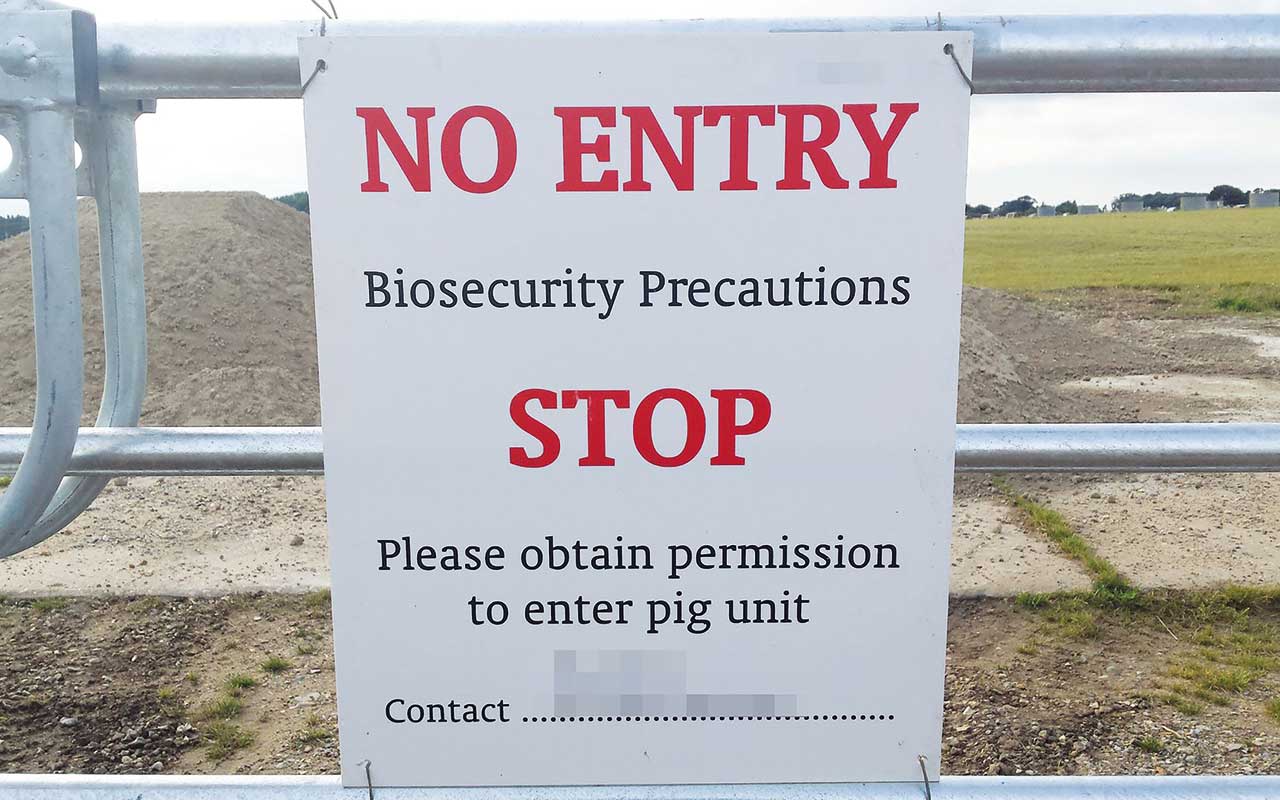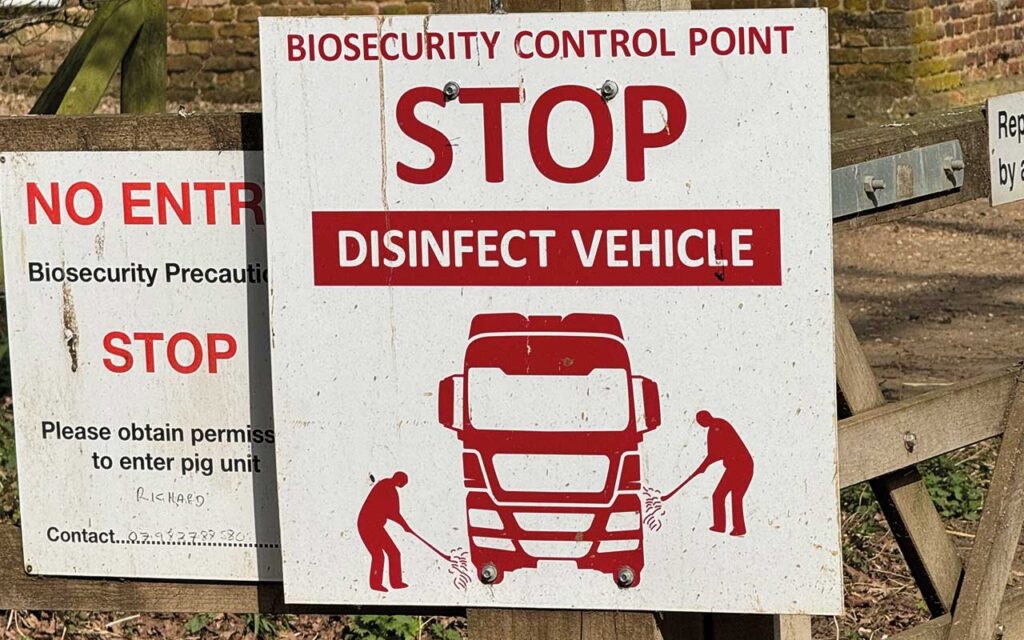Biosecurity has never been more important to the UK pig industry. Here, in a joint article, the Pig Veterinary Society, NPA and AHDB summarise key advice on maintaining disease defences on farm.
The exotic disease threat has never been greater, with African swine fever (ASF) and, more recently, foot-and-mouth disease (FMD), circulating in Europe while huge, worrying gaps remain in the UK’s border controls.
Recently, we have also seen rising cases of some key endemic diseases, notably swine dysentery. The harsh reality, according to industry experts, is that in many cases these outbreaks are entirely preventable.
While many businesses already practise excellent biosecurity, more still needs to be done to keep disease out at an industry and, often, individual level.
According to the Pig Veterinary Society, there are three fundamental principles of biosecurity that all producers and stockpeople should adhere to:
- Separate – can we prevent or reduce the contact between pigs and a contaminated animal, object or person? This doesn’t have to be a physical fence or wall – it could be preventing the crossover of feed delivery lorries with farm traffic, getting haulage to collect from the perimeter or visitors not bringing meat onto the unit.
- Clean – when we cannot segregate, cleaning must always occur before disinfection.
- Disinfect – the disinfectant should be Defra-approved and used at general orders concentration. Foot-dips and stock solutions should be refreshed regularly.
Once these principles are understood, they can be applied to almost any day-to-day situation, and it is important to involve everyone in the decisions and actions.
Any person, animal (including wildlife), vehicle or equipment has the potential to carry disease organisms onto a farm. Producers frequently overlook the fact staff are, in terms of biosecurity, ‘daily visitors’.
The farm gate is the last barrier. Animal movements are the riskiest in terms of spreading pathogens, but the spread of ASF and FMD has demonstrated the risk that other routes pose, including humans, vehicles and products of animal origin.
We also need to consider what leaves through your farm gate – the risk for onward spread should be minimised. The key message is: “Don’t rely on others to protect your unit.”
Here are some common areas producers should consider:
Pigs
- When sourcing pigs, know the health status of your herd and the pigs coming in.
- Check the health status of incoming stock and agree a suitable quarantine period in line with vaccination requirements.
- Keep records.
- Maintain a strict policy for pig contact and movement between units to limit cross-contamination.
- When loading pigs, farm staff should not enter the livestock trailer and, conversely, the haulage driver should not leave the loading ramp.
- Clean and disinfect the loading ramp after use.
- Organise the flow to keep groups separate and minimise contact with visitors.
Visitors and staff
- Keep visitors to a minimum. Do they need to enter the pig areas? Have a visitor policy and stick to it (you can say no!)
- All staff and visitors should be made aware of the risk they pose and what is expected of them to minimise that risk.
- Record everyone on and off the unit. All visitors must clearly sign the visitors’ book, including contractors, mechanics and pest controllers. In an outbreak, it is important that sources of infection and potential onward transmission routes can be easily and quickly identified.
- Area managers can be a high-risk factor, visiting multiple farms and often not signing the visitors’ book.
- Can you put in showers or create a Danish/barrier entrance? Make barriers where you want people to change PPE or stop. Add signs telling staff what you want them to do.
- Keep PPE well stocked where you need it. All staff should be provided (and must wear) outerwear and boots that are left on the farm.
- No farm staff should have contact with pigs or manure outside their employment.
- Staff should not bring any meat products onto the farm.
- Staff and visitors returning from overseas travel should notify the farm manager/owner before entering the farm.
- You could encourage staff to take short videos of their biosecurity practices to highlight poor and good practice and share in team meetings.

AHDB resources
A huge amount of resources are available on the AHDB website.
- Checklists and SOP documents covering all aspects of biosecurity on farms.
- Information about clinical signs, tests, vaccines and other preventative measures for a range of diseases, including African swine fever, porcine reproductive and respiratory syndrome, porcine epidemic diarrhoea and swine dysentery.
- Posters and notices to display on farms covering #MuckFreeTrucks, staff advice, footpaths and more.
Vehicles and #MuckFreeTrucks
- Have a designated parking area outside the biosecure area. Keep it clean.
- Make sure your signs and gates stop vehicles at the right place. Is signage clear for anyone who has not visited before? Can they find the visitors’ car park, biosecurity point and delivery drop-point without entering the pig areas?
- Provide cleansing and disinfection materials for vehicles (including your own).
- Clean and disinfect vehicles between units.
- Check any delivery vehicles that come to the unit, including the cab, for cleanliness.
- #Muckfreetrucks are particularly important ahead of the summer show season.
- Have muck-karting, muckspreading and slurry-spreading contractors arrived with clean and disinfected equipment? Where have they been previously?
- Do not allow unnecessary vehicles on site. Prevent or minimise the crossover of farm machinery with visitor traffic. Could you take deliveries further away from the pigs? Could tyre fitters and mechanics work at the perimeter?
- Cleansing facilities at abattoirs must also be up to scratch.

Equipment
- Keep it clean.
- Limit sharing of equipment.
- Try colour-coding to ensure that movement of equipment between ages of pigs is visible.
Footpaths
- Put notices up – available from AHDB.
- Make people aware of the risk they pose.
- Check perimeter fencing regularly.
- You can apply to reroute footpaths.
Carcases
- Transfer carcases promptly to secure storage to prevent access by domestic or wild animals.
- The carcase bin collection point must be located outside the main perimeter.
Disease vectors
- Deter birds and wildlife and stop contact between wild/feral boar and farmed pigs.
- Keep on top of vermin control.
- Have a zero-pigmeat policy.
- Make sure all suppliers to your unit are aware of your biosecurity policies.
Significant Diseases Charter
- If you have a case of swine dysentery, it is your responsibility to report it to the Significant Diseases Charter, so other producers and the allied industry are aware of the risk. This is a Red Tractor requirement.
Strengthen defences against ASF and other threats
African swine fever (ASF) is highly virulent and can easily be spread unknowingly between groups of pigs on the same farm, according to Julian Sparrey, technical director at Livetec Systems, a leading provider of biosecurity solutions.
“If we do see ASF infect wild pigs in the UK, it will also be critical to prevent them touching nose to nose with outdoor commercial stock. Installing double fencing – two fences, 8ft apart – around the pigs will be essential to prevent transmission,” he said.
For many diseases, the most common point of entry is infected pigs. “The first step in protecting herds is to ensure incoming pigs are sourced from reputable, disease-free suppliers and quarantined for at least four weeks before being integrated into the herd,” he said.
On-farm, biosecure zones are key to help control any disease transmission, particularly in bed-and-breakfast or mixed-farm systems.
“Each zone should have strict access controls, designated entry and exit points with step-over barriers, and specific hygiene protocols, such as changing boots and clothing when moving between zones,” Julian said. “If pigs of different ages or health statuses are kept on the same farm, separate biosecure zones are essential to avoid cross-contamination.
“Be cautious about having unnecessary visitors or moving equipment between farms unless absolutely necessary, and ensure stringent washdown procedures are followed.
“Every biosecurity protocol is there for an important reason, and staff engagement is vital to make sure these are straightforward and effective.
“With extensive industry experience, we tailor our approach to engage people at all levels, from farmworkers to senior managers, helping to ensure robust biosecurity measures are consistently followed.”
Workshops
Livetec has partnered with AHDB to deliver a series of 13 ASF contingency planning workshops across England this year, helping pig farmers and vets strengthen defences against the disease.
Working with integrators at a larger scale, it is developing its existing suite of digital tools for the pig industry, such as access to its electronic biosecurity advisory system (eBAS) tool, a digital risk assessment that helps make biosecurity decisions more data-informed.
More information on registering for these workshops will be shared soon by AHDB.




